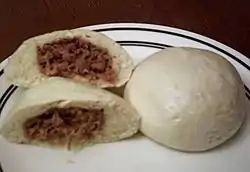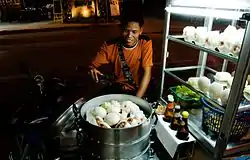Siopao
Siopao (simplified Chinese: 烧包; traditional Chinese: 燒包; Pe̍h-ōe-jī: sio-pau; Tagalog pronunciation: [ˈʃopaʊ]), literally meaning "hot bun"), is the Philippine cuisine indigenized version of the Cantonese steamed bun called cha siu bao.[1]
  Top: Siopao buns with chicken filling; Bottom: A street vendor in Chiang Mai, Thailand, selling various types of salapao | |
| Alternative names | Salapao (Thailand), Manapua (Hawaii) |
|---|---|
| Type | Baozi |
| Course | Snack, Cuisine |
| Place of origin | Philippines |
| Serving temperature | Hot |
| 0.33 kcal (1 kJ) | |
Description
It is a popular snack sold mostly by bakeries and vendors and in many Chinese restaurants and eateries in the Philippines. There are different varieties based on the filling: pork asado or bola-bola (a combination of pork, chicken, beef, shrimp or salted duck egg). There is also a variety of ways to bake.[2]
A unique variant from Siargao Island is the paowaw, a dessert bun which has a filling of bukayo (sweetened shredded coconut meat).[3]
An old urban legend or canard alleges that siopao is made from cat meat, due to the relative cheapness of siopao and Sinophobia.
In other countries
There is a similar derivative in Thai cuisine called salapao (Thai: ซาลาเปา). Salapao are sometimes made with a sweet filling for a dessert.[4] It is also a favorite in Hawaii where it is called manapua.
See also
- Cha siu bao
- Bāozi, the Chinese version of the steamed bun.
- Ma Mon Luk
- List of buns
- List of steamed foods
 Food portal
Food portal
References
- Frances Lorraine Haw-Ang (August 25, 2010). "Top 10 Siopao in Manila". www.spot.ph. Retrieved 21 December 2010.
- http://www.mixingbowl.com/content/GELACIOSFILIPINOAMERICANRECIPES/recipe/5805221/Baked-Siopao%5B%5D
- Damo, Ida. "Two Unique Snacks from Surigao: Paowaw & Milledo". ChoosePhilippines. Retrieved 28 July 2019.
- "Salapao – Chinese Steamed Buns". www.thaizer.com/. January 15, 2010. Retrieved 21 December 2010.

